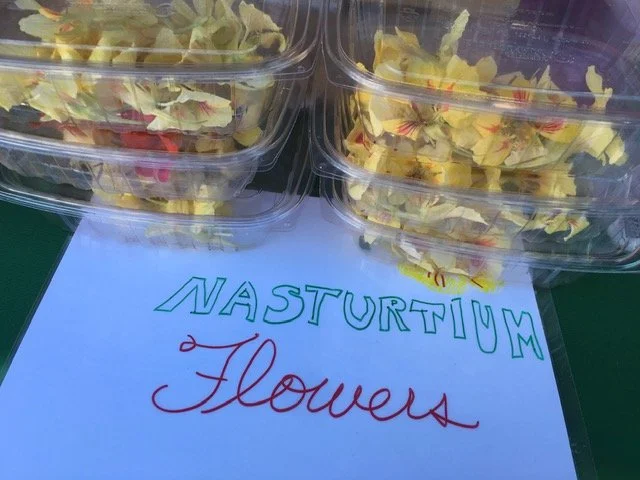Flower Power
Color is everywhere at the market when it comes to flowers. There are colorful cut blossoms of all shapes and sizes—sunflowers, snapdragons, and those oh-so-fragrant lilies. There are also potted flowers to take home and plant in our gardens, annuals and perennials abound. But the flowers that catch my eye every single time are the edible flowers such as squash blossoms and nasturtiums.
I plant more summer squash than one could possibly eat for two reasons. First, the chickens love them. I let them grow to be baseball bat sized. Anyone who h as ever grown zucchini in their own garden knows that one day they’re these cute little things the size of a Persian cucumber and before you know it you think it’s a watermelon. The smaller ones are tender and easy to cut. The larger ones make great zoodles. But the monstrous ones with the fibrous seeds will, at best, yield enough loaves of zucchini bread for all your family, friends, and folks at the office. Even with a few plants in her garden my mother gets overrun with summer squash to the point they go on a little plastic table at the end of her sidewalk with a FREE sign. And if they don’t get taken…you guessed it…they get sent home with me for the chickens.
But there’s another reason I grow summer squash in abundance—the flowers. Squash blossoms are a delicacy that can be consumed in a variety of ways. They go great in quesadillas, on pizza, in omelets, and my personal favorite, stuffed with a soft cheese such as chèvre, lightly battered and sautéed until the outer coating is crisp and the centers are warm and gooey.
Similarly, come fall you get a second chance for these delights as winter squash blossoms are also edible. Hint: if you go to a you-pick pumpkin patch you’re going to find lots of blossoms. Chances are you’ll only get charged for the big orange fruit and not the additional goodies.
Another flower finding its way into market these days are nasturtiums. In addition to adding bright colors the flowers have a spicy, peppery flavor. They can be used both fresh and cooked.
Pansies are also popular for jazzing up salads or floating on cold soups. There’s something special about finding flowers in a salad. If you really want to go fancy, try making a compound butter with minced nasturtiums and pansies for an eye-catching presentation. Flowers in a vase are nice, but a golden medallion flecked with purple, orange, and green screams you’re the best.
While not all flowers are edible, there are plenty of common garden flowers showing up in our food and drink that you may already have in your garden.
Lavender and hibiscus are commonly used in teas, herb mixes, rubs, and jams. Borage, an annual herb native to the Mediterranean, has a brilliant blue star-shaped flower with a cucumber flavor that bartenders crave for craft cocktails during the summer.
Even weeds that flower are edible. Dandelion, honeysuckle, and purslane, while the bane of many gardeners are the delicacies for gourmands with an eye for the colorful. Honeysuckle can also satisfy a sweet tooth.
The grand dame of edible flowers in your garden, yet few people ever grow for food is the rose. The rule of thumb is if a rose variety is fragrant it will also be flavorful. Rose petals on a delightful dessert are much more romantic than roses in a box. Want to make your own rosewater for your favorite Middle Eastern, Persian, and Indian recipe? Yes, it’s as simple as simmering the petals in water from a few flowers; toss in a shot of vodka if you want to save it for future use. By the way, you can get vodka at the market, too.


